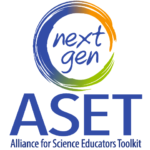
ASET Project
Alliance for Science Educators Toolkit (ASET)
The Next Gen ASET project served pre- and inservice teachers across the state of California as well as in Utah and Kentucky. Science educators, scientists, and curriculum specialists worked collaboratively over the course of five academic years to develop the Next Gen ASET Toolkit. The Next Gen ASET Toolkit was designed as a set of NGSS planning tools to support shifts in science methods course instruction towards NGSS-alignment and enactment, to effectively integrate the three dimensions outlined in the Framework (NRC, 2012; Windschitl, Thompson, Braaten & Stroupe, 2012) while still considering other effective instructional practices in science education that are commonly addressed in methods courses. The tools were implemented and improved within the context of 51 university science methods courses across 10 universities, which enrolled a total of over 1100 preservice teachers or teacher interns. Feedback from both the practitioner and end-users involved with these courses provided systematic analysis and field-testing in real education contexts to inform improvements to these tools through an iterative design process using the Improvement Science framework (Berwick, 2008; Bryk et al., 2015; Lewis, 2015). Use of the Toolkit in these courses provided visual scaffolds and supports to facilitate discussion related to shift in implementing the NGSS. While each instructor used the same Toolkit, it was flexible enough to allow for use in a variety of contexts (Sinapuelas, et al, 2018a).
The Next Gen ASET Toolkit consists of a one-page overarching graphic organizer (3D Map; Sinapuelas et al., 2018a; Sinapuelas et al., 2018b) and a set of tools with guiding criteria to support understanding of each Science and Engineering Practice (SEP Tools) across K-12 grade level bands. The toolkit link on this website provides access to the most current versions of the 3D Map and SEP Tools as well as descriptionsand supports specific to the use of each. The tools were not developed for use in isolation, but with peers to promote discourse for understanding the goals and aligning instruction for the NGSS.
To implement and test these tools across multiple university settings, a Networked Improvement Community (NIC) was launched by California State University, East Bay in June 2016. Members of this NIC represented eight universities from California, Utah and Kentucky committed to the ‘continuous improvement’ of Next Gen ASET’s NGSS planning toolkit. This NIC was formed to accomplish two goals:
- Facilitate communication and shared expertise among science education faculty members working towards a common goal of improving preservice teacher understanding of NGSS within science methods courses
- Disseminate, get feedback about, and train science education faculty members on the use of tools designed to facilitate preservice science teacher understanding of NGSS
The Networked Improvement Community (NIC) served as a robust mechanism for accelerated learning, improvement, and dissemination at scale (Bryk, et al, 2015), by leveraging interdisciplinary expertise of NIC partners, prioritizing know-how over theory, and making knowledge (i.e., findings from PDSA cycles) a “live resource” (Dolle et al., 2013, p. 444). Data produced in PDSA cycles across the NIC enabled NIC partners to collectively 1) examine variation in diverse teacher preparation programs and 2) continue to improve the tools and the processes for using them. Generalizability increased by understanding this variation and by using variation as an important data source for subsequent PDSA improvement cycles.
